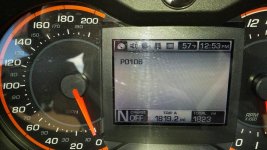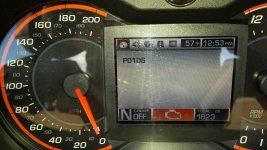Rd_Runner
Member
All, does anyone know if there is an altitude limitation on the Spyders?
I am just wondering, because, today the wife and I decided to climb Pikes Peak with our trusty new 2013 RT-S spyder. (Glad I convinced her to pack warmer jackets which we put on when were within ~ 3 miles of the summit).
At ~ 11,500 - 12000 feet (~ 4 miles from the summit) I noticed a check engine warning. The bike itself was running perfectly. The temperature never ever got above the mid-point. The bike did not hiccup, cough or sputter once during the ascent. The fault would appear to periodically clear then comeback. I carefully drove it to the rest of the way to the summit and watched all gauges and indicators like a hawk. When I reached the summit and parked the bike, I had a continues check engine light with the engine running.
Using my trust Spydercode android app I referenced it and pulled the fault code and got the following P0106:"Manifold absolute pressure circuit range/performance".
I thought it could possibly be MAP sensor related. I have know of early automotive designs that would set an ECM code when changing more than 5000 ft in elevation in a relative short period of time. In this case the fix action was: stop, turn the vehicle off then restart it after about 5 minutes. This action allows the MAP sensor to reset until you changed altitude again by more than 5000 ft.
So...I shut the spyder off, looked around, and took pictures hoping when we prepared to leave the fault would be gone.
When I started the bike up to leave I still got the check engine lindicator and it sputtered a little when starting then it quickly smoothed out. As we traveled down from 14110 ft (check the first photo) it would appear to clear then comeback just like it did on the ascent. We got to ~ 11,500 ft the check engine light cleared permanently on its own. During the entire the trip up and down Pike Peak the bike ran perfectly fine other than the short sputtering fit when re-starting it at the summit.
Based upon the error code I can only conclude the MAP sensor's range in the Spyder is inadequate when traveling above 11,500 ft. Anybody else run into this same problem?



By the way, it was bloody cold at the summit even though it was 80 degrees F in Colorado Springs which is at ~ 8600 ft altitude where we live.
Note to all: the temperature on dash read 57 degrees F in pic #2 when I took it at the Pikes Peak summit; that is definitely a big lie.:shocked:
I am just wondering, because, today the wife and I decided to climb Pikes Peak with our trusty new 2013 RT-S spyder. (Glad I convinced her to pack warmer jackets which we put on when were within ~ 3 miles of the summit).
At ~ 11,500 - 12000 feet (~ 4 miles from the summit) I noticed a check engine warning. The bike itself was running perfectly. The temperature never ever got above the mid-point. The bike did not hiccup, cough or sputter once during the ascent. The fault would appear to periodically clear then comeback. I carefully drove it to the rest of the way to the summit and watched all gauges and indicators like a hawk. When I reached the summit and parked the bike, I had a continues check engine light with the engine running.
Using my trust Spydercode android app I referenced it and pulled the fault code and got the following P0106:"Manifold absolute pressure circuit range/performance".
I thought it could possibly be MAP sensor related. I have know of early automotive designs that would set an ECM code when changing more than 5000 ft in elevation in a relative short period of time. In this case the fix action was: stop, turn the vehicle off then restart it after about 5 minutes. This action allows the MAP sensor to reset until you changed altitude again by more than 5000 ft.
So...I shut the spyder off, looked around, and took pictures hoping when we prepared to leave the fault would be gone.
When I started the bike up to leave I still got the check engine lindicator and it sputtered a little when starting then it quickly smoothed out. As we traveled down from 14110 ft (check the first photo) it would appear to clear then comeback just like it did on the ascent. We got to ~ 11,500 ft the check engine light cleared permanently on its own. During the entire the trip up and down Pike Peak the bike ran perfectly fine other than the short sputtering fit when re-starting it at the summit.
Based upon the error code I can only conclude the MAP sensor's range in the Spyder is inadequate when traveling above 11,500 ft. Anybody else run into this same problem?



By the way, it was bloody cold at the summit even though it was 80 degrees F in Colorado Springs which is at ~ 8600 ft altitude where we live.
Note to all: the temperature on dash read 57 degrees F in pic #2 when I took it at the Pikes Peak summit; that is definitely a big lie.:shocked:

